The Distribution Pattern of the Railway Network in China at the County Level
Abstract
:1. Introduction
2. Materials and Methods
2.1. Research Area and Data Sources
2.2. Methods
3. Results
3.1. Spatial Pattern of Railway Network Density
3.2. Spatial Pattern of Railway Network Proximity
3.3. Spatial Pattern of the Shortest Travel Time
3.4. Spatial Pattern of Railway Network Distribution
4. Discussion
4.1. Railway Network Distribution in Urban Agglomerations
4.2. Railway Network Distribution in Four Economic Regions
4.3. Limitations and Future Improvements
5. Conclusions
Author Contributions
Funding
Acknowledgments
Conflicts of Interest
References
- The World Bank. World Development Indicators. Available online: https://data.worldbank.org (accessed on 17 April 2019).
- UIC. High Speed Line in The World. Available online: http://www.uic.org/spip.php?mot8 (accessed on 17 April 2019).
- Rodrigue, J.P.; Comtois, C.; Slack, B. The Geography of Transport Systems; Routledge: New York, NY, USA, 2009. [Google Scholar]
- Jin, F.; Wang, C.; Li, X.; Wang, J. China’s regional transport dominance: Density, proximity, and accessibility. J. Geogr. Sci. 2010, 20, 95–309. [Google Scholar] [CrossRef]
- Geurs, K.T.; Van Wee, B. Accessibility evaluation of land-use and transport strategies: Review and research directions. Transp. Geogr. 2004, 12, 127–140. [Google Scholar] [CrossRef]
- Monzon, A.; Lopez, E.; Ortega, E. Has HSR improved territorial cohesion in Spain? An accessibility analysis of the first 25 years: 1990–2015. Eur. Plan. Stud. 2019, 27, 1–20. [Google Scholar] [CrossRef]
- Wang, J.; Jin, F.; Mo, H.; Wang, F. Spatiotemporal evolution of China’s railway network in the 20th century: An accessibility approach. Transp. Res. Part A Policy Pract. 2009, 43, 765–778. [Google Scholar] [CrossRef]
- Hansen, W.G. How accessibility shapes land use. J. Am. Plan. Assoc. 1959, 25, 73–76. [Google Scholar] [CrossRef]
- Morris, J.M.; Dumble, P.L.; Wigan, M.R. Accessibility indicators for transport planning. Transp. Res. Part A General. 1979, 13, 91–109. [Google Scholar] [CrossRef]
- Jiao, J.; Wang, J.; Jin, F.; Dunford, M. Impacts on accessibility of China’s present and future HSR network. J. Transp. Geogr. 2014, 40, 123–132. [Google Scholar] [CrossRef]
- Bruinsma, F.; Rietveld, P. The accessibility of European cities: Theoretical framework and comparison of approaches. Environ. Plan. A 1998, 30, 499–521. [Google Scholar] [CrossRef]
- Beria, P.; Debernardi, A.; Ferrara, E. Measuring the long-distance accessibility of Italian cities. J. Transp. Geogr. 2017, 62, 66–79. [Google Scholar] [CrossRef]
- Black, J.; Conroy, M. Accessibility measures and the social evaluation of urban structure. Environ. Plan. A 1977, 9, 1013–1031. [Google Scholar] [CrossRef]
- Yang, L.; Zhang, X.; Hong, S.; Lin, H.; Cheng, G. The impact of walking accessibility of public services on housing prices: Based on the cumulative opportunities measure. South China J. Econ. 2016, 1, 57–70. [Google Scholar]
- Dou, K.; Zhan, Q. Accessibility analysis of urban emergency shelters: Comparing gravity model and space syntax. In Proceedings of the 2011 International Conference on Remote Sensing, Environment and Transportation Engineering, Nanjing, China, 24–26 June 2011. [Google Scholar]
- Franke, D.; Vorel, J.; Peltan, T. Job accessibility modelling in Prague Functional Urban Area. In Proceedings of the 2017 Smart City Symposium Prague (SCSP), Prague, The Czech Republic, 25–26 May 2017. [Google Scholar]
- Ministry of Civil Affairs of the People’s Republic of China. Administrative Division of the People’s Republic of China; Chinese Social Publishing House: Beijing, China, 2017.
- Yao, S.M. Urban Agglomerations of China; University of Science and Technology of China Press: Hefei, China, 2006. [Google Scholar]
- Gu, C.L.; Yu, T.F.; Li, W.M. Urbanization in China: Pattern, Process and Mechanism; Science Press: Beijing, China, 2008. [Google Scholar]
- Fang, C.L.; Bao, C.; Ma, H.T. Urban Agglomeration Development in China; Science Press: Beijing, China, 2016. [Google Scholar]
- Fan, J.; Li, P.X. The scientific foundation of major function-oriented zoning in China. J. Geogr. Sci. 2007, 19, 515–531. [Google Scholar] [CrossRef]
- Wang, G.T. National Urban System Planning 2006–2020; The Commercial Press: Beijing, China, 2010. [Google Scholar]
- National Bureau of Statistics of China. Available online: http://www.stats.gov.cn/ztjc/zthd/sjtjr/dejtjkfr/tjkp/201106/t20110613_71947.htm (accessed on 17 April 2019).
- National Bureau of Statistics of China. China County Statistical Yearbook; China Statistics Press: Beijing, China, 2016.
- National Bureau of Statistics of China. China City Statistical Yearbook 2016; China Statistics Press: Beijing, China, 2016.
- Li, M.; Guo, R.; Li, Y.; He, B.; Chen, Y.; Fan, Y. Distribution Characteristics of the Transportation Network in China at the County Level. IEEE Access 2019, 7, 49251–49261. [Google Scholar] [CrossRef]
- Hu, H.; Wang, J.; Jin, F.; Ding, N. Evolution of regional transport dominance in China 1910–2012. J. Geogr. Sci. 2015, 25, 723–738. [Google Scholar] [CrossRef]
- Xu, S.B. The Principle of Analytic Hierarchy Process—Practical Decision-Making Method; Tianjin University Press: Tianjin, China, 1988. [Google Scholar]
- Erath, A.; Löchl, M.; Axhausen, K.W. Graph-theoretical analysis of the Swiss road and railway networks over time. Netw. Spat. Econ. 2009, 9, 379–400. [Google Scholar] [CrossRef]
- Huang, Y.; Lu, S.; Yang, X.; Zhao, Z. Exploring railway network dynamics in China from 2008 to 2017. ISPRS Int. J. Geo-Inf. 2018, 7, 320. [Google Scholar] [CrossRef]
- Kasraian, D.; Maat, K.; Vaan Wee, B. The impact of urban proximity, transport accessibility and policy on urban growth: A longitudinal analysis over five decades. Environ. Plan. B Urban Anal. City Sci. 2017, 1, 1–18. [Google Scholar] [CrossRef]
- Blainey, S.P.; Armstrong, J.; Smith, A.S.; Preston, J.M. New routes on old railways: Increasing rail’s mode share within the constraints of the existing railway network. Transportation 2016, 43, 425–442. [Google Scholar] [CrossRef]
- Huber, S.; Rust, C. Calculate travel time and distance with OpenStreetMap data using the Open Source Routing Machine (OSRM). Stata J. 2016, 16, 416–423. [Google Scholar] [CrossRef]
- Zhang, D.; Chow, C.Y.; Liu, A.; Zhang, X.; Ding, Q.; Li, Q. Efficient evaluation of shortest travel-time path queries through spatial mashups. GeoInformatica 2018, 22, 3–28. [Google Scholar] [CrossRef]
- Chinese Academy of Sciences. Provincial-Level Functional Area Division; Science and technology of China press: Beijing, China, 2008. [Google Scholar]
- Li, M.; He, B.; Guo, R.; Li, Y.; Chen, Y.; Fan, Y. Study on population distribution pattern at the county level of China. Sustainability 2018, 10, 3598. [Google Scholar] [CrossRef]
- National Development and Reform Commission. The Issuance of the Medium-and Long-Term Railway Network Plan 2016. Available online: http://www.ndrc.gov.cn/zcfb/zcfbtz/201607/t20160720_811696.html (accessed on 17 April 2019).
- Xie, F.; Levinson, D. Modeling the growth of transportation networks: A comprehensive review. Netw. Spat. Econ. 2009, 9, 291–307. [Google Scholar] [CrossRef]
- Levinson, D. Density and dispersion: The co-development of land use and rail in London. J. Econ. Geogr. 2007, 8, 55–77. [Google Scholar] [CrossRef]
- Li, X.; Huang, B.; Li, R.; Zhang, Y. Exploring the impact of high speed railways on the spatial redistribution of economic activities-Yangtze River Delta urban agglomeration as a case study. J. Transp. Geogr. 2016, 57, 194–206. [Google Scholar] [CrossRef]
- Duan, G.Y.; Gong, H.L.; Liu, H.H.; Zhang, Y.Q.; Chen, B.B.; Lei, K.C. Monitoring and analysis of land subsidence along Beijing-Tianjin Inter-city railway. J. Indian Soc. Remote Sens. 2016, 44, 915–931. [Google Scholar]
- Li’e, S.B.W. Spatial Pattern & Quantitative Relationship of Industrial Structure of Shandong Peninsula Urban Agglomeration. In Proceedings of the 3rd International Conference on Information Science and Control Engineering (ICISCE), Beijing, China, 8–10 July 2016. [Google Scholar]
- Zhou, J.; Yang, L.; Li, L. The implications of high-speed rail for Chinese cities: Connectivity and accessibility. Transp. Res. Part A Policy Pract. 2018, 116, 308–326. [Google Scholar]
- Lim, H.; Thill, J.C. Intermodal freight transportation and regional accessibility in the United States. Environ. Plan. A 2008, 40, 2006–2025. [Google Scholar] [CrossRef]
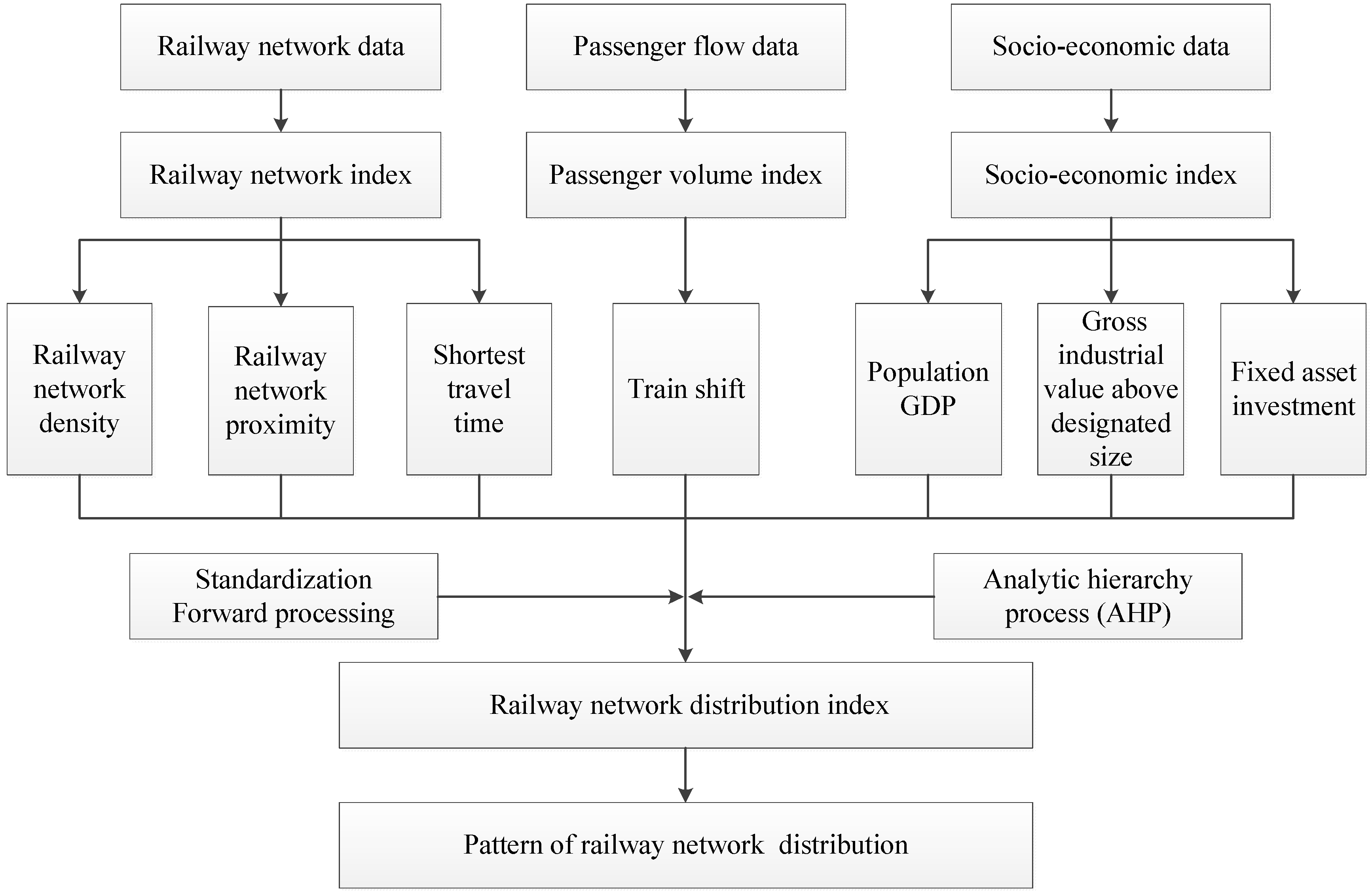
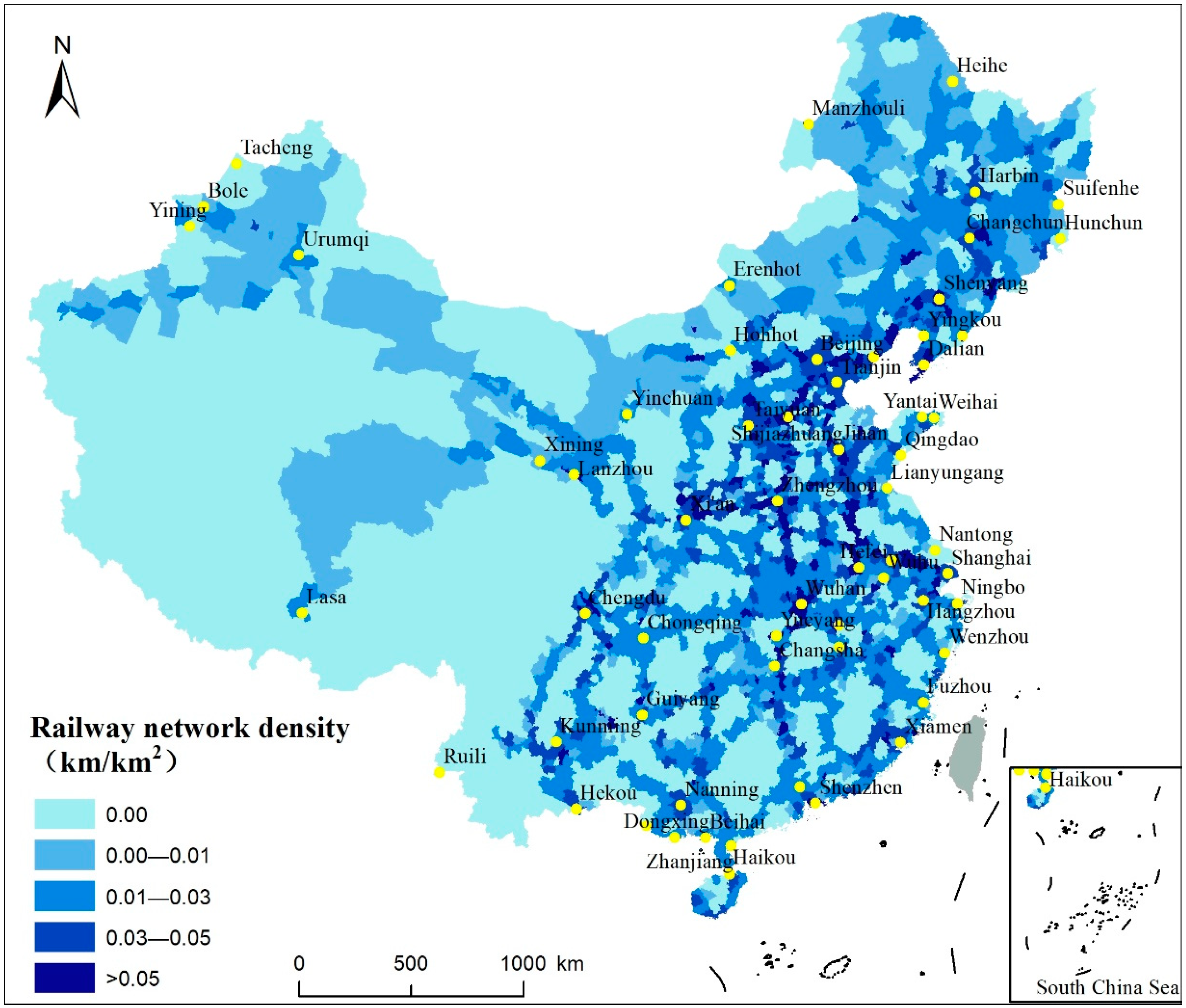
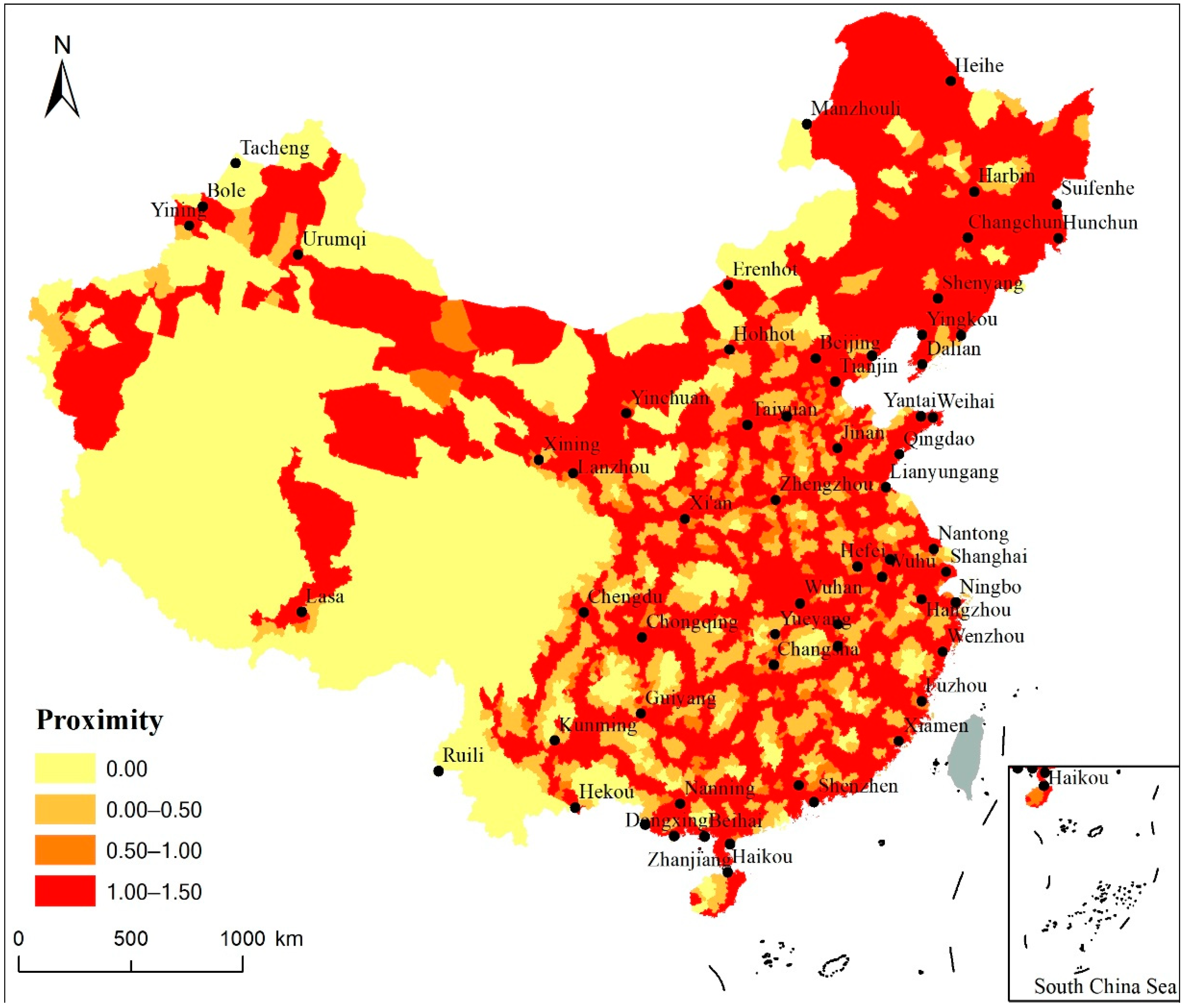
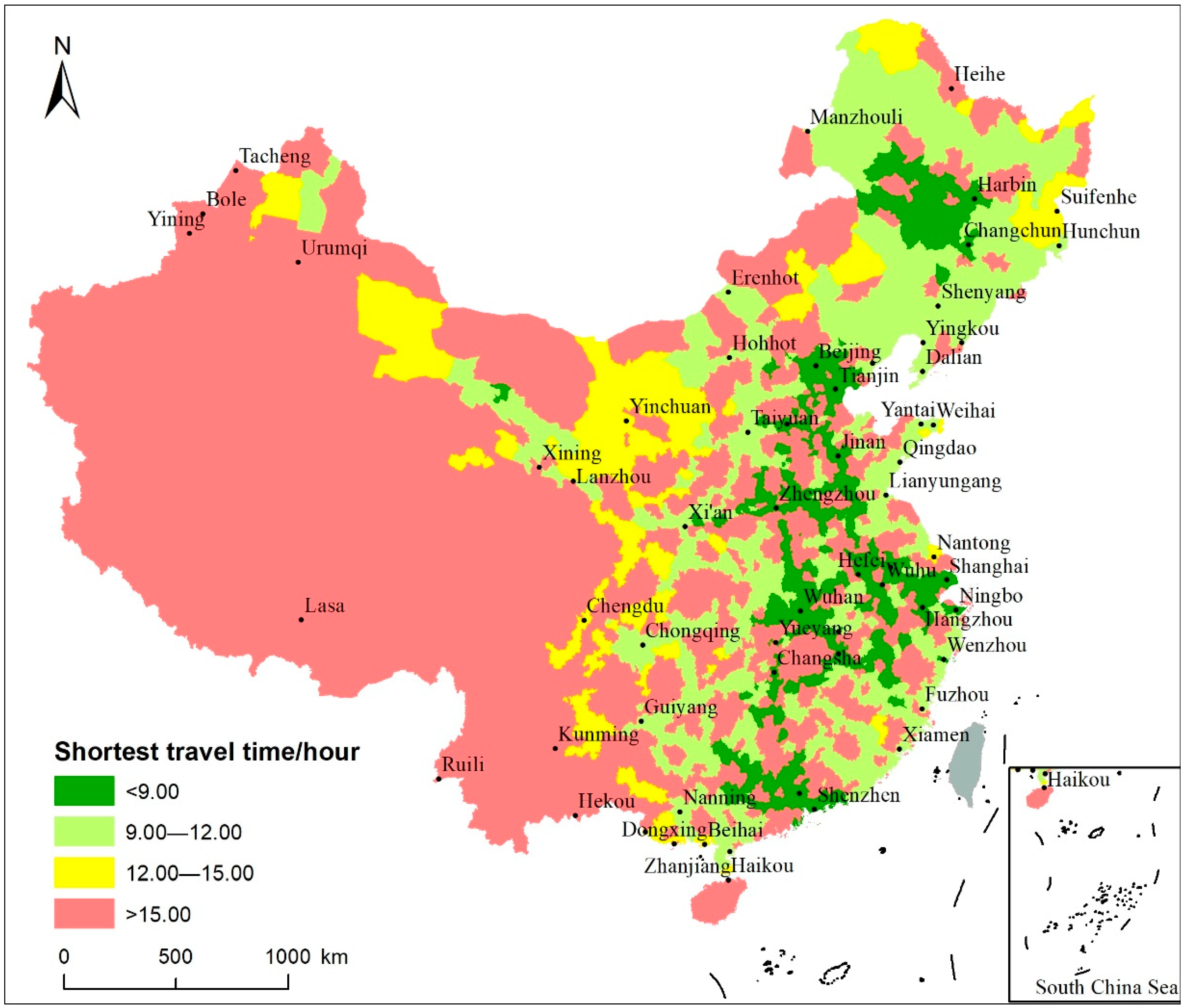
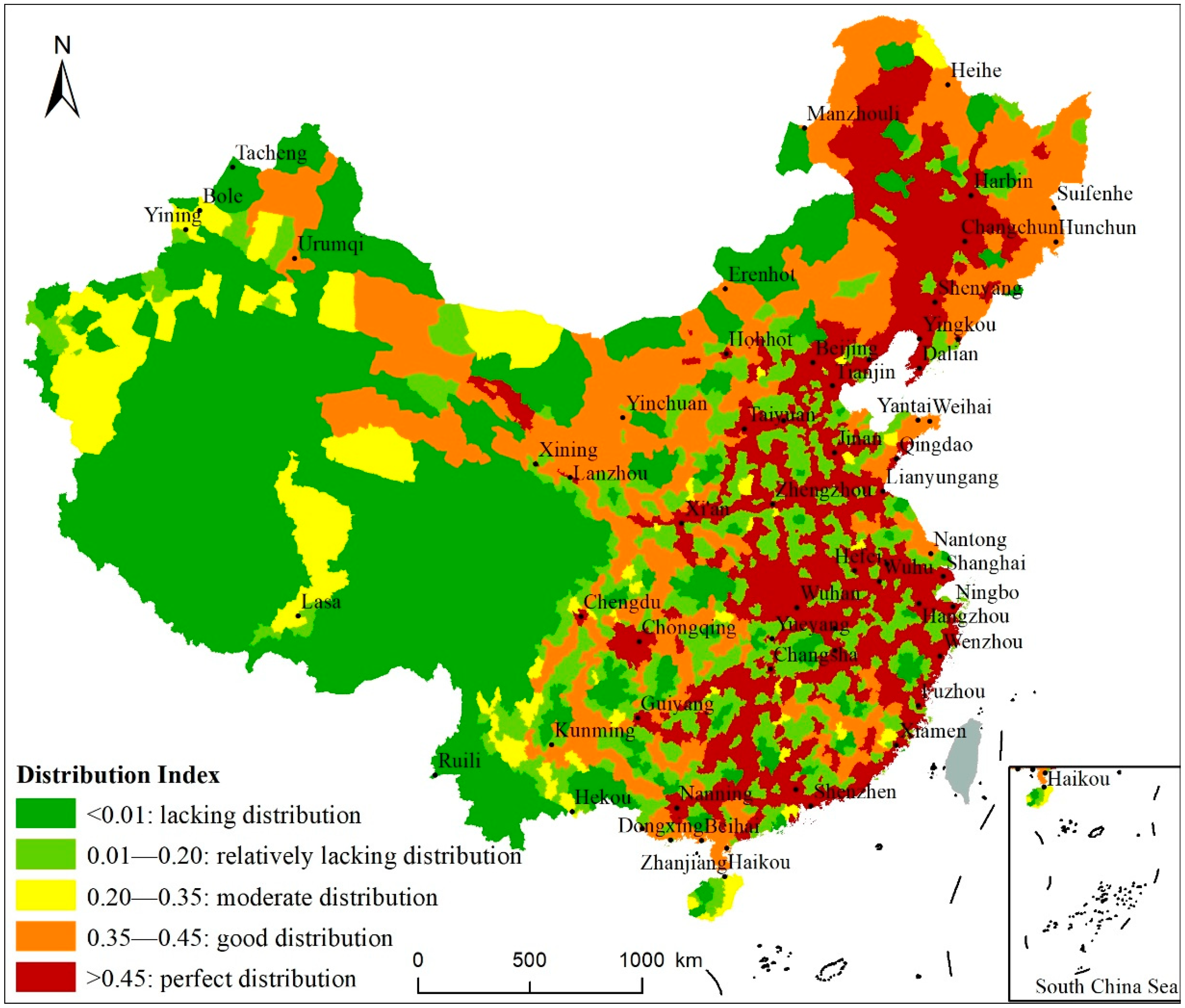
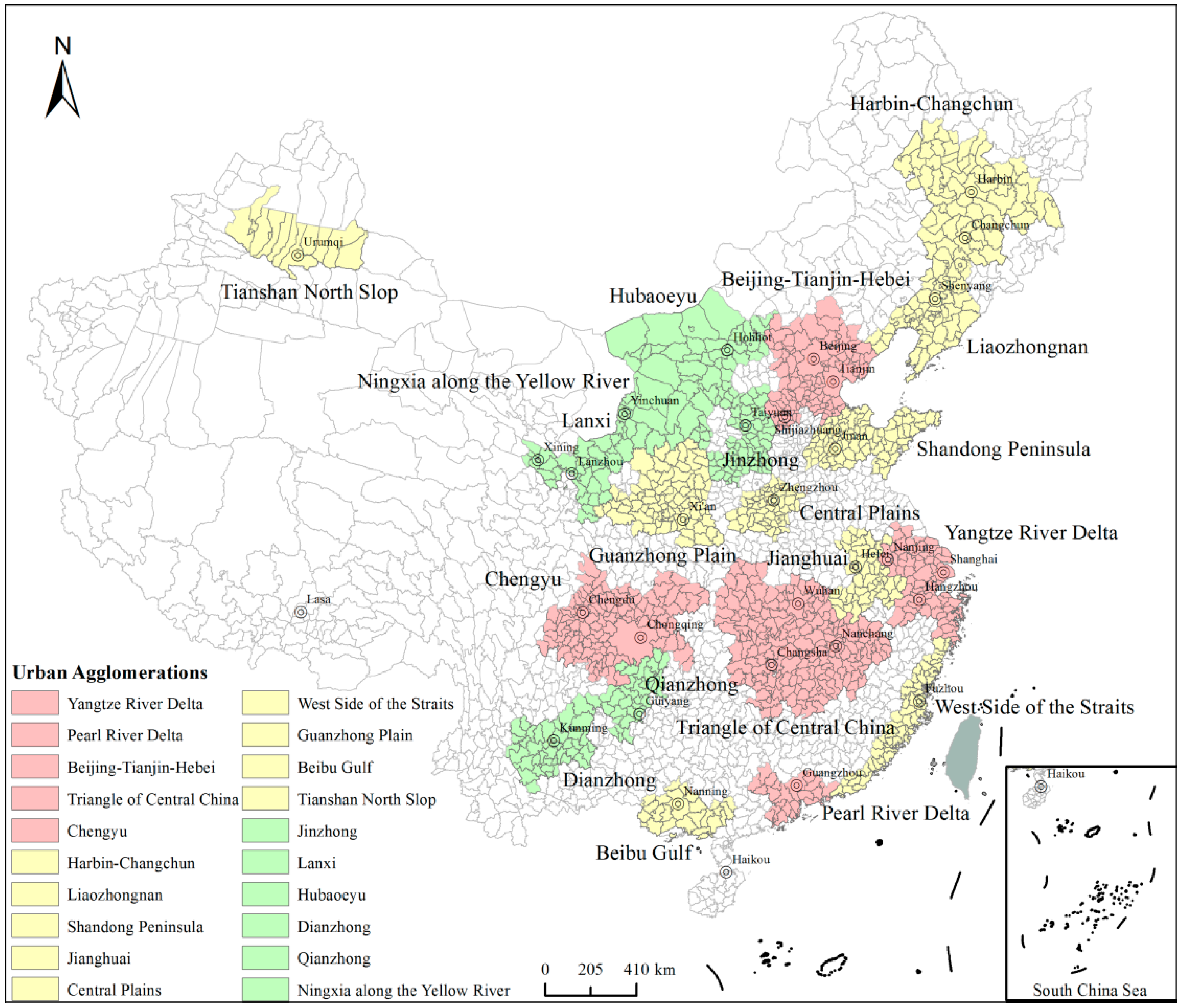
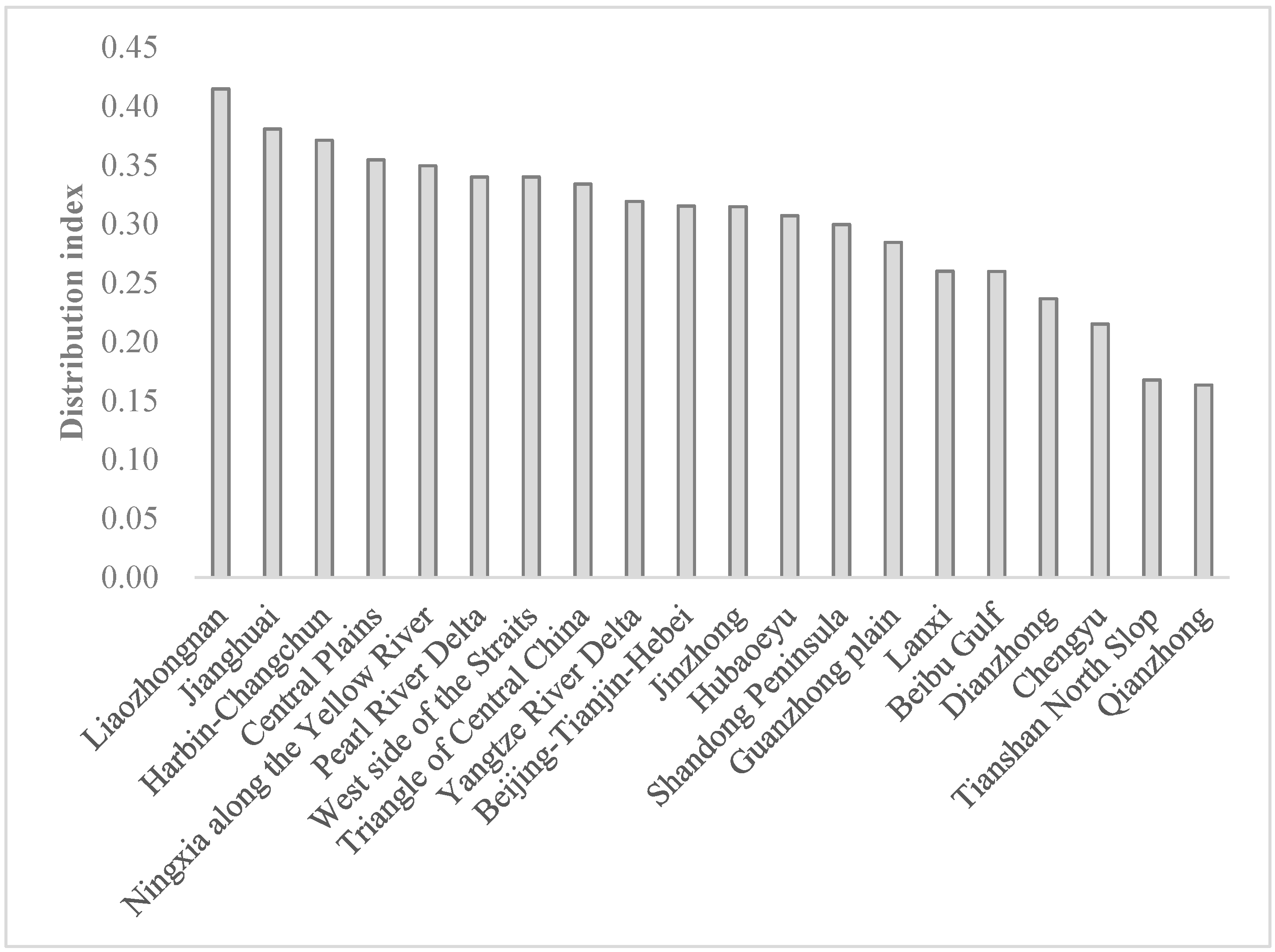
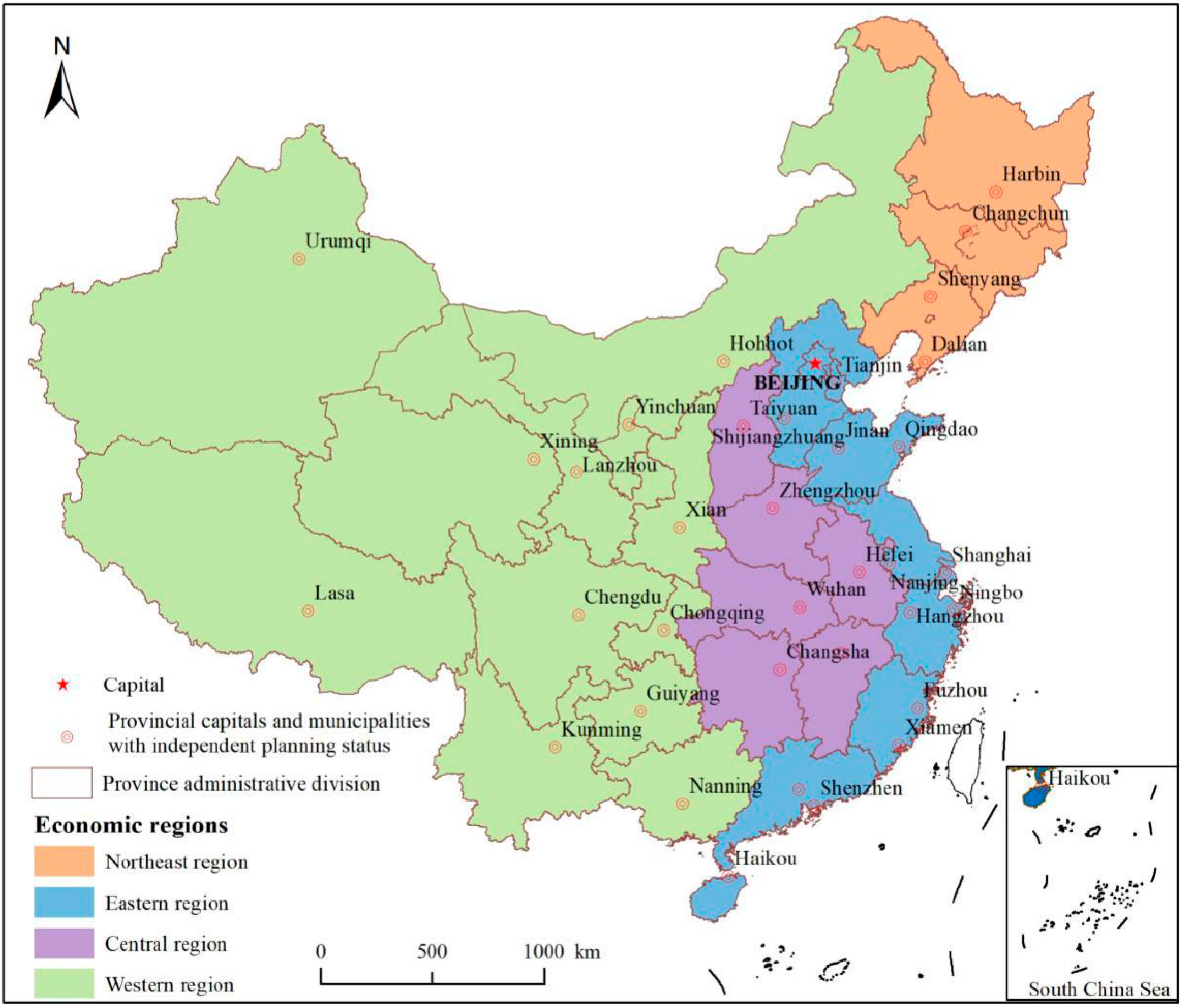
| Name | Source | Time | Method |
|---|---|---|---|
| Land area, population, GDP, gross industrial value above designated size, fixed asset investment | China County Statistical Yearbook, China City Statistical Yearbook | 2015 | Spatial visualization |
| Railway line network, Railway stations, train frequency | AMAP, Railway Customer Service Center of China | 2015 | Web crawler technology |
| Type | Standard | |
|---|---|---|
| Railway | Own railway station | 1.5 |
| L ≤ 30 km | 1.0 | |
| 30 km < L ≤ 60 km | 0.5 | |
| L > 60 km | 0.0 |
© 2019 by the authors. Licensee MDPI, Basel, Switzerland. This article is an open access article distributed under the terms and conditions of the Creative Commons Attribution (CC BY) license (http://creativecommons.org/licenses/by/4.0/).
Share and Cite
Li, M.; Guo, R.; Li, Y.; He, B.; Fan, Y. The Distribution Pattern of the Railway Network in China at the County Level. ISPRS Int. J. Geo-Inf. 2019, 8, 336. https://doi.org/10.3390/ijgi8080336
Li M, Guo R, Li Y, He B, Fan Y. The Distribution Pattern of the Railway Network in China at the County Level. ISPRS International Journal of Geo-Information. 2019; 8(8):336. https://doi.org/10.3390/ijgi8080336
Chicago/Turabian StyleLi, Minmin, Renzhong Guo, You Li, Biao He, and Yong Fan. 2019. "The Distribution Pattern of the Railway Network in China at the County Level" ISPRS International Journal of Geo-Information 8, no. 8: 336. https://doi.org/10.3390/ijgi8080336
APA StyleLi, M., Guo, R., Li, Y., He, B., & Fan, Y. (2019). The Distribution Pattern of the Railway Network in China at the County Level. ISPRS International Journal of Geo-Information, 8(8), 336. https://doi.org/10.3390/ijgi8080336






